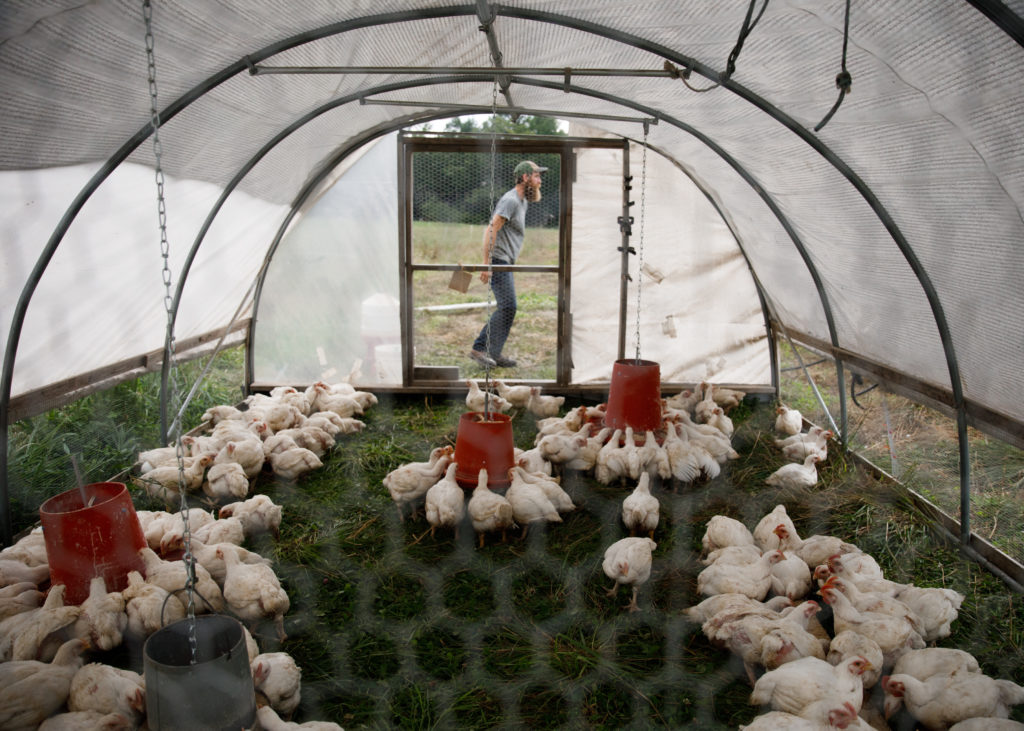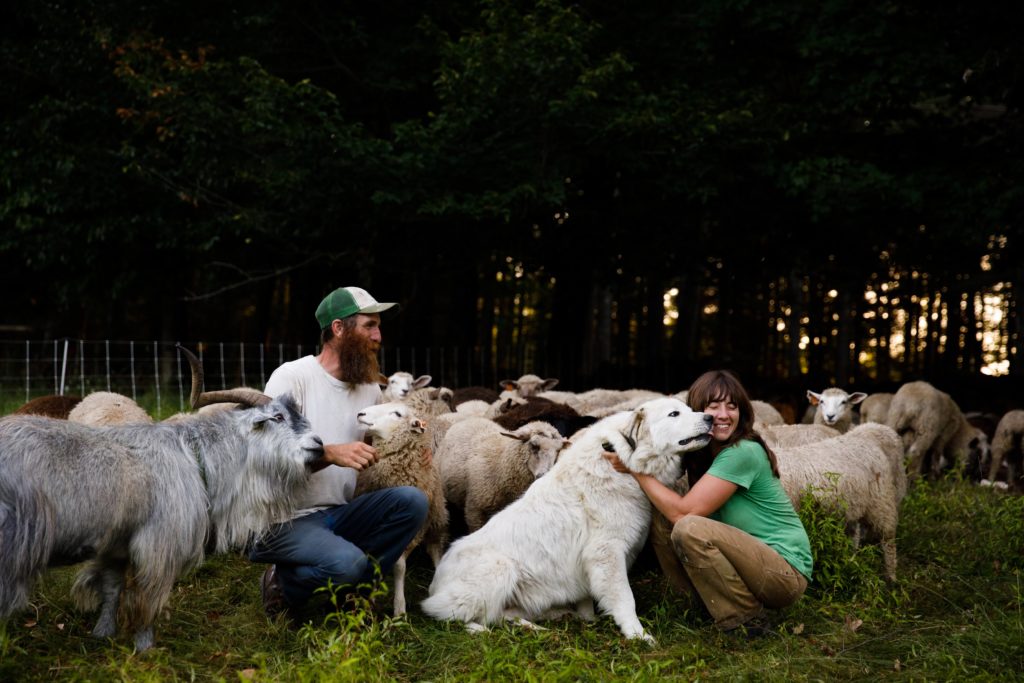By Holli Cederholm
In Bowdoinham, Maine, farmers Abby Sadauckas and Jake Galle of Apple Creek Farm raise a diverse mix of grass-based, certified organic livestock for eggs and meat, as well as value-added bone broths and pate, sold year-round at local farmers’ markets and a handful of retail outlets. Aspects of holistic management have informed the farm’s development, Sadauckas explained in her presentation on pasture-based livestock profitability at MOFGA’s 2020 Farmer to Farmer Conference in November.
The pair assumed management of Apple Creek Farm in 2014 from Galle’s parents, who founded it in 1985 with a flock of sheep and three kids – which Galle is the youngest of. In a video produced for the Bowdoinham Open Farm & Art Trail, showcased at the beginning of Sadauckas’ presentation, Galle said, “I grew up making hay in the fields that we still currently make hay out of with my dad and my brother and my sister and my mom.”
The “Home Farm,” as they call the land leased from Galle’s family, has 35 acres of pasture claimed from mixed woods and pine groves over the course of 40 years. In 2014, Sadauckas and Galle purchased 70 adjacent acres and began clearing 12 of them. Additionally, they lease 10 hayfields, totaling 60 acres, and 15 acres of pasture for rotational grazing.

Diversity on the Farm
Apple Creek Farm raises beef cows, chickens (for both eggs and meat), goats and sheep, and turkeys and geese for the holidays. “We’re able to manage the diversity of critters that we have because of the diversity of acreage. These different fields are good for different stuff,” said Sadauckas.
For example, their North American Cashmere goats are used to manage the woods and edge areas, helping to reclaim pasture from encroaching bittersweet. “The goats are a non-chemical method for controlling invasives,” said Sadauckas.
Broilers are predominantly raised in a 13-acre field that they cleared in 2011 at Home Farm. Like much of the land the farm utilizes, the soils have a USDA land capability designation of Class 6, which means they need careful management such as rotational grazing and lots of fertility. Chickens produce the needed fertility and help to spread it, too.
Most of the soils on the farm are stony and not well-drained. “Our strategy really is to add a ton of organic matter,” said Sadauckas.
This includes planting annual forages. Parcels of land that get “beat up,” like winter cow yards, are seeded to millet which can be used for warm-season grazing. For land recently taken out of forest, the farmers utilize no-till drilling to seed forage crops – adding species diversity to their grazing lands.
Holistic Management
When they started farming together, Sadauckas and Galle identified their values in order to provide a framework for their operation. Having holistic goals allows them to better assess opportunities and to prioritize investments on the farm, including “what to say no to,” said Sadauckas.
The goal of “being calm and not having stress” has heavily impacted decisions on the farm, such as undertaking a lot of financial planning to eliminate stress related to cashflow. The farm business is separate from their personal finances, and has been since they started farming in 2009. To avoid a stressful lifestyle, they set goals to not be out in the field late every night, to have time to relax and to take vacations.
Wanting to reduce stress also influences their livestock management practices more specifically. Identifying points of stress helped Sadauckas and Galle determine crucial infrastructure purchases, including a livestock trailer (to better control ideal times for loading livestock) and head gates (to improve upon their cattle-breeding setup). “These have been pretty invaluable in ensuring that we can handle the animals in a safe way,” said Sadauckas.
Strategic Marketing
They first joined the Brunswick winter market in 2011, and it remains the backbone of the farm’s marketing strategy today. By primarily selling their products in the winter, they were able to focus on production in the summer. They now market year-round and have scaled up farmers’ markets attendance to three days per week and also participate in the Merry Meeting Kitchen online food hub, where customers can order products for pick-up at Apple Creek Farm’s market booth, at Merry Meeting Kitchen or right at the farm
As proponents of nose-to-tail eating, they get everything back from the butcher – and sell it all. Their list of value-added offerings, processed using Turtle Rock Farm’s co-packing services, includes grass-fed fats, bone broth, and chicken liver pate and mousse. Having value-added products, and offering a range of items, helps to increase the total sales per customer, said Sadauckas. She noted that they spend a lot of time educating their customers so they know how to use the farm’s products, are happy with them and keep coming back for more.
“We strive to offer all our products on a year-round basis and are building out our production to match our market in southern Maine,” said Sadauckas.
Broilers
In 2011, Apple Creek Farm began raising broiler chickens in batches of 50 to sell as frozen, whole birds. They’ve since scaled up to batches of 200 and anticipate growing to 300 in 2021.
Two different chicken breeds selected for performance on pasture, Cornish Crosses and Red Bro, are sheltered in floorless hoop houses that get moved onto fresh grass every morning. The structures measure around 12-14 feet by 16 feet, and have roll-up sides and a covered door at each end. This design allows them to “catch that spring sunshine without that spring wind,” said Sadauckas.
The chickens are allowed to “day range” on pasture as they grow, but are shut into the houses at night to keep them safe from predators: like the farm’s resident family of great horned owls.
Sadauckas noted that the houses allow for more control of the broilers’ environment and, as a result, the birds grow better – they’re less susceptible to disease and hypothermia. The coops also mean an early start on production: Apple Creek Farm starts processing fresh birds for Memorial Day and continues processing 100 to 150 birds on a weekly basis through Labor Day.
To maximize profitability with chickens, they switched from selling only whole birds to selling cuts. “Boneless, skinless breasts are a very good seller and the price point we strive for gives us enough profit that in 2018 it covered our entire processing/slaughter bill for broilers,” said Sadauckas.
Feed, of course, is one of their biggest costs. They reduce this expense by buying grain in bulk and through using hanging feeders, sourced from Kuhl Corporation, that can be adjusted based on the birds’ age and size to reduce waste.

Laying Hens
Sadauckas and Galle rotate their flock of Bovan Red hens onto fresh pasture every week using a system of movable coops and flexible fencing. When cold weather hits, the hens are transferred to a 30-by-72-foot Rimol hoop house outfitted with rollaway nest boxes which collect the eggs in a drawer, keeping them relatively clean (thereby reducing labor).
The system was originally designed for 200 to 250 hens but they ended up with 500 16-week-old pullets when another farm changed their mind regarding a joint order. It proved a serendipitous mistake as Sadauckas cannot imagine going back to raising 200 hens. In terms of increased workload, there’s more eggs to wash – 500 hens yield 30 to 35 dozen per day – but otherwise it’s “essentially the exact same thing.”
Though in 2020, Apple Creek Farm kept on an older flock to meet increased eggs demands brought on by COVID-19, bringing their flock up to 900 hens yielding 70 to 75 dozen eggs daily. Having eggs consistently available has helped their farm’s cashflow and created wholesale opportunities with Morning Glory Natural Foods in Brunswick and Royal River Natural Foods in Freeport.
Laying hens also provide a lot of on-farm fertility, saving Apple Creek from having to import it at a premium as they continue to build the soils on their farm. Other savings come from purchasing supplies in bulk and reusing egg cartons. Though, as with broilers, profitability is largely maximized through feed.
They follow Jeff Mattocks’ recommendations for feeding based on stage-of-life. These rations help to achieve a goal of maintaining an 85% lay rate during the two or so years they keep each flock. As one group of layers age, they add a round of pullets and, after their eggs size up, retire the older hens – either selling them as backyard flocks or processing them into stew birds.
Cows
Apple Creek Farm is a cow-calf operation. In the fall of 2020, their six, primarily Angus-cross, brood cows birthed the first round of calves bred by artificial insemination on the farm; they switched from keeping a shared bull in 2018. “We are fall-calving because we have sheep and goats and chicks and all of these things happening in the spring,” said Sadauckas.
Calves are weaned in the spring at six-months-old and moved to leased pasture. Then finishing animals (which are raised for at least 24 months prior to slaughter) and brood cows are pastured together. Occasionally they will add goats to the same paddock. “They graze different things and they graze different heights,” said Sadauckas, noting that goats will snip off the heads of Queen Anne’s lace that the cows ignore.
The farmers add value to their beef operation through selling by the cut, and by offering sausage and hot dogs, in addition to ground beef. “We weren’t sure if our customers would be interested in the hot dogs, but they are and they appreciate knowing what’s in them,” said Sadauckas.
Sheep
Sheep have been around since the early days of Apple Creek. Galle’s parents started raising them in the 1980s, selecting animals based on wool quality. Sadauckas and Galle now focus on size. They have introduced both a Clun Forest ram and a Bluefaced Leicester to their mixed breed flock and are especially impressed with the genetics introduced by the latter. “We’ve seen, just in one season, what that change in genetics can do to increase carcass size,” said Sadauckas.
Each year they retain 10 to 12 lambs to build their breeding stock. They aim for 50 ewes total, with expansion limited by the size of their barn which was built for housing 20 animals, along with their winter feed, by Galle’s parents. They intend to build a new barn in the next year or two so they can scale up to their target number of sheep and goats.
To add value to their sheep enterprise, they process between 25 and 50 sheepskins a year and sell them at farmers’ markets and online.

Goats
Sadauckas started raising goats in Unity before she started farming with Galle. She considered raising Boer goats but was dissuaded by a lack of available breeding stock in the state. Inspired by mentors at both Springtide Cashmere in Bremen and Black Locust Farm in Washington, she settled on North American Cashmere goats instead. She knew that she could sell the cashmere back to a breeder and also knew that she would be able to source a buck for growing her herd.
Apple Creek Farm now keeps two bucks, which they run with their sheep in the off-season to avoid unwanted breeding, and 25 does. Similar to sheep, they want to expand their goat herd to meet market demand – they sell goat meat by the cut in addition to fiber – and are working on new management systems, including the addition of a hoop house for winter shelter.
Turkey & Geese
Both turkey and geese, while fairly easy to manage, are expensive for the farm to raise. Goslings cost $15 each to buy in, and the farmers have found that they need to sell goose meat for $12 per pound to offset their costs. This, in addition to limited processing availability for waterfowl, has caused them to eliminate production in certain years.
Turkeys, Sadauckas noted, require a certain scale to achieve profitability, in part, because of the cost of the poults: for Apple Creek Farm that’s a minimum of 200 birds annually. Similar to other poultry on the farm, the birds are pastured using movable hoop houses.
Largely destined as the centerpieces of holiday meals, turkeys create a level of stress that other animals on the farm do not. “The marketing is challenging because for every turkey there’s a person and every person has a family that they’re going to feed that turkey to,” said Sadauckas. “The expectations for this bird are incredibly high.”
It’s also challenging to get the sizing right. “It’s the only thing we try not to grow as big as we can,” said Sadauckas.
The stress of marketing holiday turkeys doesn’t fit into the farm’s holistic management goals so they’re exploring other models including cooperative marketing. Another model they like is raising the animals for ground turkey, rather than whole birds, which eliminates the seasonality of the market – there’s demand for their turkey year-round.
Like with all of the pasture-based meats offered by Apple Creek Farm, their customers can taste the difference. “We always joke that the secret ingredient to our meat is lots of fresh grass and sunshine,” said Sadauckas.
